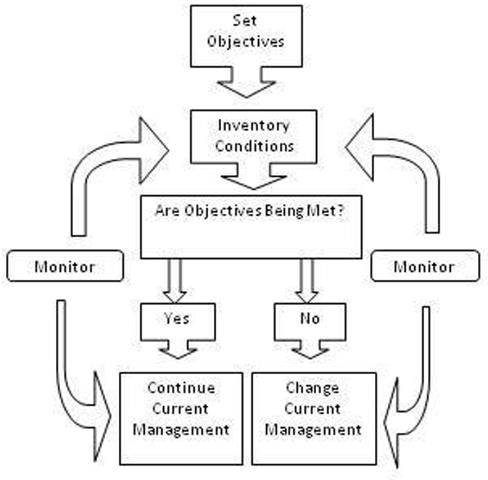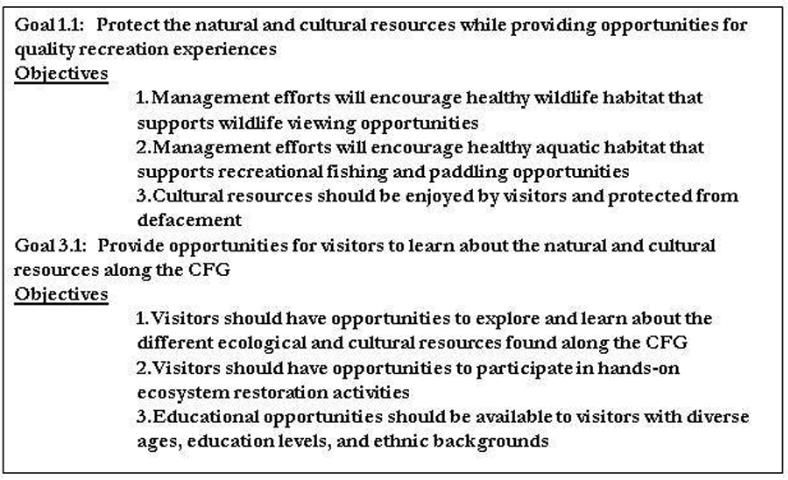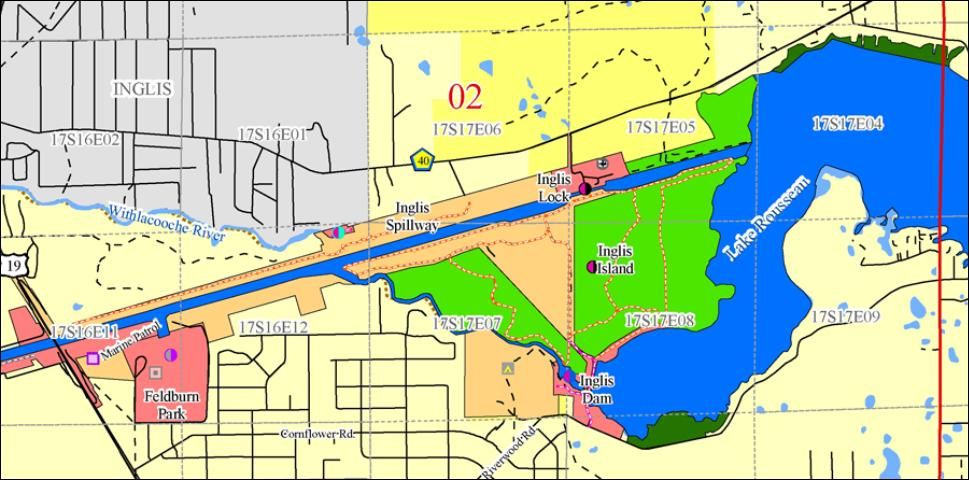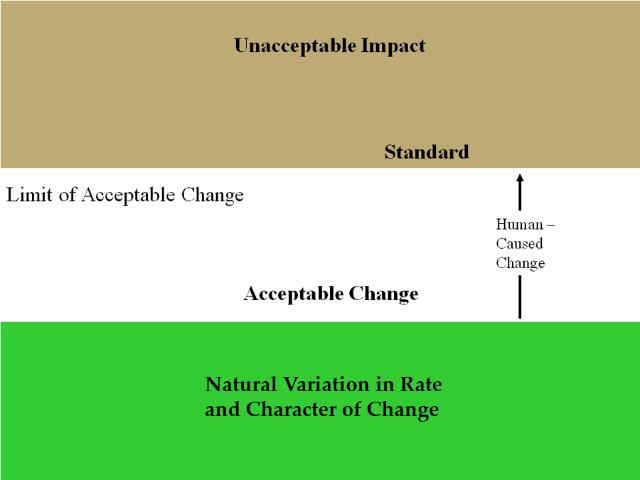The Attraction of Nature
Nature is wonderful thing. Whether it's water, land, forests, prairies, or a mix of many ecosystems, people love to be in nature. They often fly thousands of miles, spend thousands of dollars, and spend thousands of hours just to hike through an old growth forest, canoe down a spring run, or see an endangered bird. All that people require to enjoy nature is the ability to get into it.
This sounds easy enough, but, as any land manager can attest, trying to balance the public's enjoyment of natural resources along with the conservation of those resources can be a difficult task. As this paper will show, finding this balance is not impossible. With systematic planning, land managers can provide many different recreational opportunities and find ways to make recreation benefit ecosystems, instead of simply reacting to problems associated with recreation.
The Need for a Plan
To achieve the maximum benefit from a natural area, managers must create a plan to guide their actions (Mazzotti and Morgenstern 1996). Land managers have long known how important it is to develop natural resource plans, particularly when managing for timber, livestock, and wildlife. Managing for recreation, on the other hand, usually was limited to marking a trail and building a bathroom and a picnic table at the trailhead. Because of the great natural appeal of Florida's environments, for many years land managers were able to provide millions of people with valuable experiences in these public lands without detailed, scientific plans to lead the way. Now that the importance of planning for recreation is more widely known, visitors to Florida's natural environments can expect an even more enriching experience.
Without a plan, many potential benefits might not be realized. Well-planned natural recreation opportunities offer great rewards to visitors (e.g., improved understanding of the environment), local communities (e.g., increased tourism income), the environment (e.g., increased stewardship and ownership), and natural organizations (e.g., increased awareness and support for the organization). Also, if recreational use of natural areas continues to grow, land managers might soon be overwhelmed with vast numbers of people and their associated ecological and social impacts that undoubtedly will arise. A solid plan at the outset can offset these impacts.
This paper lays out a general process to help managers plan for how to use recreation to provide benefits to their organization, environment, visitors, and local communities. The paper does not cover how to plan for specific activities in natural areas. There are simply too many different things that people can do in nature and it's up to the organizations, themselves, to identify what specific activity opportunities they want to provide.
Existing Recreation Planning Frameworks
Nature-based recreation researchers and professionals have worked for decades to develop scientifically-based planning frameworks that address the social and ecological issues inherent in nature-based recreation planning. Although there are several, three frameworks most often used by public land management agencies are described here.
Limits of Acceptable Change
In the early 1980s, the US Forest Service developed the Limits of Acceptable Change (LAC) framework to help managers plan for recreation's negative ecological and social impacts (Stankey et al., 1985). The framework was derived from the carrying capacity concept. A natural area's "carrying capacity" is usually thought of as the number of people who can enter the area without causing it unacceptable damage. As thinking evolved on how to best manage for recreation, however, managers began to understand that the idea of "carrying capacity" was actually more complex. The number of visitors was not the direct problem, they realized. In fact, it was the impacts visitors have on the environment and on the experiences of other visitors that were the main concerns. LAC's nine-step process helped managers move beyond thinking simply about visitor numbers and instead to focus their planning on managing for acceptable impacts or changes to the resource and visitor experience.
See Stankey et al. https://doi.org/10.5962/bhl.title.109310 (February 2023).
Recreation Opportunity Spectrum
Instead of planning simply to avoid impacts, recreation researchers and managers worked together to develop a strategy to plan to improve the overall quality of recreation. This strategy was based on the fact that a diverse public demands diverse recreation experiences. The Recreation Opportunity Spectrum (ROS) is a zoning framework designed to give managers guidelines on how to plan for diverse recreation opportunities (Clark and Stankey, 1979). ROS describes a range of settings (primitive to urban) and provides a guide on how to manage the bio-physical, social, and managerial characteristics of a setting with the explicit goal of providing opportunities for visitors to attain desired recreation experiences.
See Clark and Stankey https://www.fs.usda.gov/pnw/pubs/pnw_gtr098.pdf (February 2023).
Visitor Experience and Resource Protection
Finally, using the carrying capacity concept, LAC, and ROS, the National Park Service worked with recreation researchers to develop the Visitor Experience and Resource Protection (VERP) framework in the early 1990s to help their managers create holistic recreation plans for their units (Fefer, Urioste-Stone, Daigle, and Silka. 2018). VERP is an 11-step process that covers the development of interdisciplinary teams to modifying management strategies after a plan has been implemented. Of all the recreation management frameworks, it is probably the most comprehensive and the one that applies to the greatest diversity of areas. VERP helps managers identify and manage for acceptable conditions while at the same time giving managers guidelines for managing settings to provide recreation opportunities. Also, it states that managers must work with diverse stakeholders when moving through the planning process.
General Planning Strategy
The remainder of this paper will describe a general planning framework that incorporates the major steps of these frameworks described above (Figure 1).

Set Objectives
A variety of organizations and agencies manage land and water for recreation. Organizations like the US Fish and Wildlife Service have a strong mandate to protect natural habitats. In contrast the Florida State Park System has several areas where recreation use is the focus. Based on these mandates and mission statements, managers must first identify the goals and objectives for the lands they manage. Managers must then plan to communicate this message to their visitors. Communicating the agency's mission or goals will result in a better informed public. An informed public understands that different natural resource organizations manage resources for different purposes and that recreation might just be one of many uses of that area. Specific indications for where and how to communicate this message should be included in the management plan.
For specific units managed by public agencies, managers must also work to integrate the public into the development of these goals. Effective citizen engagement is vitally important at the beginning of the planning process. Without significant public buy-in to an area's plan, managers might be opening the door to unnecessary conflict with the very people who care about the land. Integrating them early in the process will improve the chances of developing productive relationships with these same people.
To ensure quality recreation, recreation management plans must include social goals and objectives as well as ecological objectives. Goals are broadly written statements that highlight the overarching benefit managers should work to provide. Objectives are more focused statements that address specific benefits and key in on potential management actions to help provide opportunities to realize those benefits (Figure 2).

Key Concept: Recreation Opportunity Zones
Zoning for recreation opportunities is an important concept when establishing goals and objectives, and ROS provides an important tool in establishing these recreation opportunity zones. Not every natural area can achieve all the goals and objectives listed in a plan; therefore, planners must zone their area (or areas) into recreation opportunity zones (Figure 3). They are considered "opportunity zones" because the manager should consider what type of benefits can best be achieved from an area and then provide an opportunity for those benefits to be realized. For example, a goal of a recreation management plan might be to provide for family bonding and improved social bonds. Picnic areas that are designed for easy access and large groups to meet and interact could be developed to help promote opportunities for people to attain those benefits. In contrast, the same organization might want to provide opportunities for people to escape and relieve stress. In an area geographically distinct from a group picnic area, managers could design isolated trails or remote picnic areas, areas that do not promote social interaction but allow visitors to be alone in nature, away from the sight and sounds of other people.

Inventory Conditions
Before designing recreation opportunities, managers must know the existing condition of the area. For example, a county might be designing a trail system around a small creek running through a natural area. The health of the creek's riparian area (i.e., banks and vegetation) is of primary importance to managers for both ecological reasons (i.e., riparian areas are often sensitive and biologically diverse) and social reasons (i.e., riparian areas are often aesthetic and potentially educational). Therefore, managers need to inventory the condition of the riparian area. The inventory could include water quality variables, vegetation mapping, and soil density. If recreation is already occurring in the area, managers could measure social variables like visitors' perceived scenic quality of the riparian area and satisfaction with activities associated with the area.
Key Concept: Indicators
According to Lime, Anderson, and Thompson (2004, p. iii), indicators are "specific, measurable variables that reflect the conditions of an overall park resource or management zone." Managers could be overwhelmed with the many different variables they could use as key indicators of recreation quality; therefore, managers must choose a realistic number of indicators to inventory at the beginning of the project and to check regularly to monitor recreation impacts. Managers should choose and list in the plan those indicators that reveal impacts considered to be serious problems and that are cost effective (Hammitt, Cole, and Monz 2015).
Are objectives being met?
If managers have written clear objectives and chosen effective indicators, they should be able to clearly identify new recreation opportunities to develop, and they should be able to evaluate the success or failure of existing recreation management. In essence, managers are comparing the existing conditions, which are measured through their indicators, with the managerial objectives listed in the plan. They should create new opportunities in any areas not currently providing for the recreation goals and objectives in the plan. For some underused areas, managers might want to seek out professionals trained in landscape architecture, engineering, environmental interpretation, and other fields.
In areas where recreation already exists, managers should use the recreation plan to evaluate the existing conditions and suggest necessary changes. For example, if the key indicators are showing that a recreation setting (bio-physical and social) is reaching managerial objectives, managers can stay the course. However, if those indicators are showing that the bio-physical or social conditions do not comply with the objectives, management actions are required. For example, a plan's objectives might state that a specific trail system should be designed to provide stress relief benefits. However, visitor surveys of the area show large groups are using the trail system for physical fitness, and visitors looking for stress relief are dissatisfied with their experience in that area. Although people are using the trail and benefiting from it (physical fitness benefits), the trail is not achieving its established objectives (stress relief benefits), and managers must either change their management to provide for stress relief benefits or redesignate the objectives for that area to reflect its actual use.
Key Concept: Standards
The key concept that relates indicators to objectives is standards. Lime, Anderson, and Thompson (2004, p. iv) define standard as the "minimally acceptable condition of indicator variables" (Figure 4). In other words, a standard specifically identifies the threshold of acceptability for bio-physical and social indicator variables and is closely tied to the objectives. Although science can help inform the development of standards (e.g., identifying how much trampling a specific plant species can tolerate or measuring how many people can be seen in an area before visitors feel crowded), standards are essentially subjective judgments made by qualified experts (Hammitt, Cole, and Monz 2015). Working with informed stakeholders and area scientists, managers can set reasonable standards of recreation quality.

Management
This paper does not cover the multiple strategies and tactics available to manage visitors and recreation settings. All areas hosting recreation visitors require some sort of management. It can be indirect, passive management like providing information and directional signage to trails or observation areas, or the management can be much more direct, for instance, requiring all visitors to follow a guide through an area. In most cases, however, nature-based recreation does not require intense and expensive management. Of course, many sites have areas of concentration like parking lots, visitor centers, restrooms, and other facilities. Management of these areas is dependent upon the facilities' physical capabilities and capacity.
Natural resource managers must be aware that simply allowing access to their properties will require some degree of management. In other words, the manager must begin making staffing decisions and allocating financial resources right away after making the decision to host visitors. Even when a natural area is particularly valuable for recreation opportunities, if staffing and funding are not available to manage the planned recreation use, allowing visitors would be potentially risky both to the property and to the visitors themselves. It's best to secure the staff and resources dictated in the management plan before opening the gates!
Conclusion
Nature-based recreation requires just as much planning as any use of natural areas. This paper was designed to give organizations a start in formulating such a plan. Much of the actual process will require inventorying the area to determine appropriate locations for activities, collaborating with stakeholders, determining the desired objectives that recreation could provide, and identifying the financial costs and benefits of providing different opportunities. Managers will also need to determine how recreation fits into their organization's mission and be creative in identifying recreation options. Finally, managers must remember that the plan is only the beginning. Actual development, management, and monitoring of recreation will be required.
Citations
Ashok, S, H.R. Tewari, M.D Behera, A. Majumdar. "Development of ecotourism sustainability assessment framework employing Delphi, C&I and participatory methods: A case study of KBR, West Sikkim, India." Tourism Management Perspectives 21 (2017): 24-41.
Ceballos-Lascuráin, H. (1996). Tourism, ecotourism, and protected areas: The state of nature-based tourism around the world and guidelines for its development. IUCN, Gland, Switzerland, and Cambridge, UK.
Clark, J.K. and T.V. Stein. (2003). Marjorie Harris Carr Cross Florida Greenway Recreation Plan. Gainesville: University of Florida Institute of Food and Agricultural Sciences.
Clark, R.N. and G.H. Stankey. (1979). The Recreation Opportunity Spectrum: A framework for, management, planning, and research. USDA Forest Service. Pacific Northwest Forest and Range Experiment Station. PNW-GTR-93. Corvalis, OR. https://srs.fs.usda.gov/pubs/6014 (February 2023).
Cole, D.N. (1989). Wilderness Campsite Monitoring Methods: A Sourcebook. USDA Forest Service. Intermountain Research Station. INT-GTR-259. Ogden, UT. https://winapps.umt.edu/winapps/media2/leopold/pubs/179.pdf (February 2023).
Eagles, P.F.J. and P. Nilsen. (1997). Ecotourism: An Annotated Bibliography for Planners and Managers. The Ecotourism Society: North Bennington, VT. https://ecotourism.org/ (February 2022).
Fefer, J,S.M Urioste-Stone, J Daigle, and L. Silka. "Understanding the Perceived Effectiveness of Applying the Visitor Experience and Resource Protection (VERP) Framework for Recreation Planning: A Multi-Case Study in US National Parks." The Qualitative Report 23.7 (2018): 1561-1582.
Hammitt, W.E., D.N. Cole, and C.A Monz. (2015). Wildland Recreation: Ecology and Management. John Wiley and Sons: New York.
Hendee, J.C. and C.P Dawson. (2008) Wilderness Management: Stewardship and Protection of Resources and Values. Fulcrum Publishing: Golden, CO.
Lime, D.W., D.H. Anderson, and J.L. Thompson. (2004). Identifying and Monitoring Indicators of Visitor Experience and Resource Quality: A Handbook for Recreation Resource Managers. St. Paul, MN: University of Minnesota, Department of Forest Resources. 62 pp.
Lindberg, K. and D.E. Hawkins, (Eds.). (1993). Ecotourism: A Guide for Planners and Managers. The Ecotourism Society: North Bennington, VT. https://ecotourism.org/ (February 2022).
Mazzotti, F. J. and C. Morgenstern. (1996). A Scientific Framework for Managing Urban Natural Areas. SSWEC74, Gainesville: University of Florida Institute of Food and Agricultural Sciences. https://doi.org/10.32473/edis-uw112-1996 (February 2023).
Stankey, G.H., D.N. Cole, R.C. Lucas, M.E. Petersen, and S.S. Frissell. (1985). The Limits of Acceptable Change (LAC) System for wilderness planning at https://doi.org/10.5962/bhl.title.109310 (February 2023).
USDA Forest Service. (1995). Landscape Aesthetics: A Handbook for Scenery Management. USDA Forest Service. Agricultural Handbook Number 701. Washington, DC.